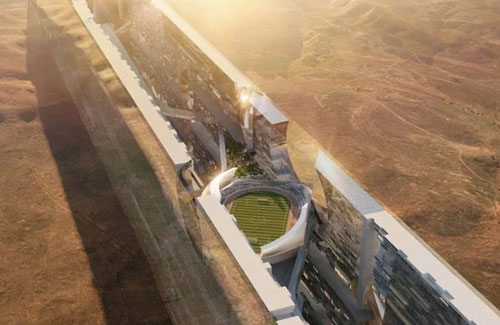A futuristic Saudi megacity is to feature two sky-scrapers extending across a swathe of desert and mountain terrain, according to the latest disclosures on the project by the kingdom’s de facto ruler.
The parallel structures of mirror-encased sky-scrapers extending over 170 kilometres, known collectively as The Line, form the heart of the Red Sea megacity NEOM, a plank of Crown Prince Mo-hammed bin Salman’s bid to diversify the Gulf state’s oil-dependent economy.
First announced in 2017, NEOM has consis-tently raised eyebrows for proposed flourishes like flying taxis and robot maids, even as architects and economists have questioned its feasibility.
In a presentation, Prince Mohammed sketched out an even more ambitious vision, describing a car-free utopia that would become the planet’s most liveable city “by far”.
Project’s ‘first phase’ will be completed by 2030 at a cost of 1.2tr riyals, says Saudi crown prince
Analysts noted, though, that plans for NEOM have changed course over the years, fuelling doubts about whether The Line will ever become reality. NEOM was once touted as a regional “Silicon Val-ley”, a biotech and digital hub spread over 26,500sq-km (10,000 square miles).
Now it’s a vehicle for reimagining urban life on a footprint of just 34sq-km, and addressing what Prince Mohammed describes as “liveability and environmental crises”.
“The concept has morphed so much from its early conception that it’s sometimes hard to determine its direction: scaling down, scaling up, or making an aggressive turn sideways,” said Robert Mogielnicki of the Arab Gulf States Institute in Washington.
Population boom
Officials had earlier said NEOM’s population would top one million, but Prince Mohammed said the number would actually hit 1.2 million by 2030 before climbing to nine million by 2045. The eye-popping total is part of a hoped-for na-tionwide population boom that Crown Prince Mo-hammed said would be necessary to make Saudi Arabia, the world’s biggest crude exporter, an eco-nomic powerhouse.
The goal for 2030 is to have 50 million people — half Saudis and half foreigners — living in the kingdom, up from roughly 34 million today.
“That’s the main purpose of building NEOM, to raise the capacity of Saudi Arabia, get more citizens and more people in Saudi Arabia. And since we are doing it from nothing, why should we copy normal cities?” The site will be powered by 100 per cent renewable energy and feature “a year-round temper-ate micro-climate with natural ventilation”, a video released on Monday mentioned.
Finding funds
At just 200 metres wide, The Line is intended to be Saudi Arabia’s answer to unchecked and wasteful urban sprawl, layering homes, schools and parks on top of each other in what planners term “Zero Gravity Urbanism”.
Residents will have “all daily needs” reachable within a five-minute walk, while also having access to other perks like outdoor skiing facilities and “a high-speed rail with an end-to-end transit of 20 minutes”, according to a statement.
Though NEOM will operate under its own founding law, which is still being prepared, Saudi officials say they have no plans to waive the king-dom’s alcohol ban.
An airport is already operational at NEOM, and authorities announced in May it would begin receiv-ing regular flights from Dubai, but it is unclear whether major construction of the megacity itself has commenced.
First phase to cost $319bn
NEOM said on Tuesday it would create 380,000 jobs by the end of the decade “whilst providing the ultimate work-life balance”. The “first phase” of the project, lasting until 2030, will cost 1.2 trillion Saudi riyals (roughly $319 billion), Prince Mohammed said.
Besides government subsidies, potential sources of funding include the private sector and an initial public offering for NEOM expected in 2024, he added.
Securing the necessary financing remains a po-tential challenge, though the current climate is more favourable than during the coronavirus pandemic that lowered oil prices. “But funding is only part of the equation… de-mand is harder to buy, especially when you’re asking people to be part of an experiment on living and working in the future,” Mogielnicki said.—AFP










